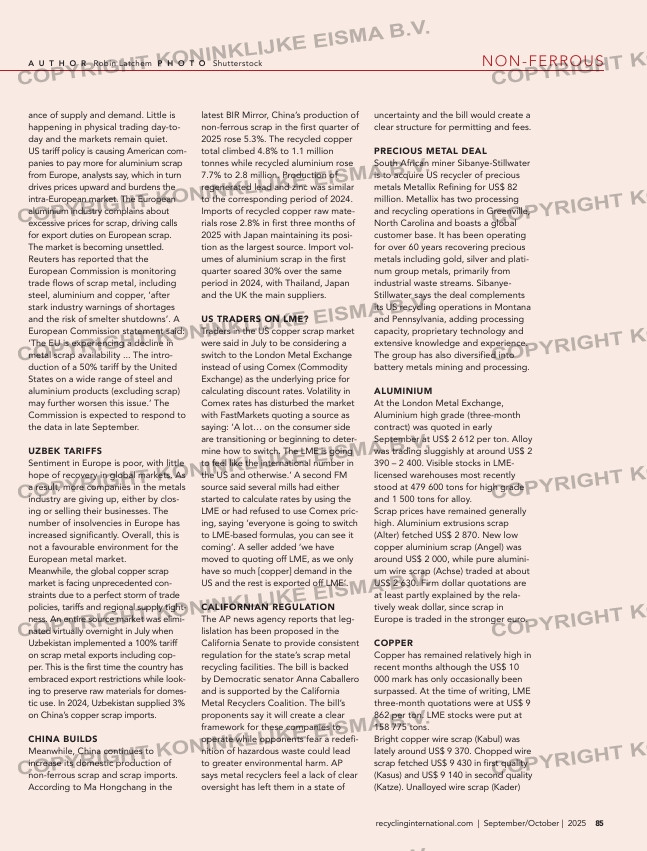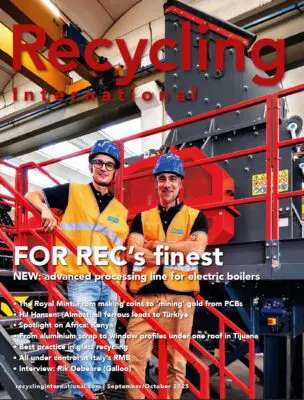Page 93 from: Recycling International September/October 2025

NON-FERROUS
Tariffs, tariffs, tariffs ance of supply and demand. Little is happening in physical trading day-to-day and the markets remain quiet.
US tariff policy is causing American com-
panies to pay more for aluminium scrap
from Europe, analysts say, which in turn
drives prices upward and burdens the
intra-European market. The European
aluminium industry complains about
excessive prices for scrap, driving calls
for export duties on European scrap.
The market is becoming unsettled.
Reuters has reported that the
European Commission is monitoring
trade flows of scrap metal, including
steel, aluminium and copper, ‘after
stark industry warnings of shortages
and the risk of smelter shutdowns’. A
European Commission statement said:
‘The EU is experiencing a decline in
metal scrap availability … The intro-
duction of a 50% tariff by the United
States on a wide range of steel and
aluminium products (excluding scrap)
may further worsen this issue.’ The
Commission is expected to respond to
the data in late September.
UZBEK TARIFFS
Sentiment in Europe is poor, with little
hope of recovery in global markets. As
a result, more companies in the metals
industry are giving up, either by clos-
ing or selling their businesses. The
number of insolvencies in Europe has
increased significantly. Overall, this is
not a favourable environment for the
European metal market.
Meanwhile, the global copper scrap
market is facing unprecedented con-
straints due to a perfect storm of trade
policies, tariffs and regional supply tight-
ness. An entire source market was elimi-
nated virtually overnight in July when
Uzbekistan implemented a 100% tariff
on scrap metal exports including cop-
per. This is the first time the country has
embraced export restrictions while look-
ing to preserve raw materials for domes-
tic use. In 2024, Uzbekistan supplied 3%
on China’s copper scrap imports.
CHINA BUILDS
Meanwhile, China continues to
increase its domestic production of
non-ferrous scrap and scrap imports.
According to Ma Hongchang in the
85recyclinginternational.com | September/October | 2025
that will be subject to the Section 232
tariffs. They included shredder wear
parts as well as lifters, material han-
dlers and loading conveyors. Shredder
wear parts were also due to suffer a
further 25% loading under the longer-
standing Section 301 tariffs but on 2
September they were exempted for a
further three months.
The expanded scope of products was
liable for the 50% duty from 18 August
with no exception for goods in transit.
Importantly for the recycled materials
industry, however, recycled aluminium
and steel remained out of scope of the
Section 232 tariffs.
A small duty exists on lead-bearing
ores but there is no indication of any
sweeping Section 232 tariffs on lead
or lead-derived products. Zinc is
explicitly exempt from US import tar-
iffs.
EUROPEAN ANGST
The situation on the European metal
markets remains tense. Although
metal prices remain high – including
for scrap – they do not reflect the bal-
A U T H O R Robin Latchem P H O T O Shutterstock
latest BIR Mirror, China’s production of
non-ferrous scrap in the first quarter of
2025 rose 5.3%. The recycled copper
total climbed 4.8% to 1.1 million
tonnes while recycled aluminium rose
7.7% to 2.8 million. Production of
regenerated lead and zinc was similar
to the corresponding period of 2024.
Imports of recycled copper raw mate-
rials rose 2.8% in first three months of
2025 with Japan maintaining its posi-
tion as the largest source. Import vol-
umes of aluminium scrap in the first
quarter soared 30% over the same
period in 2024, with Thailand, Japan
and the UK the main suppliers.
US TRADERS ON LME?
Traders in the US copper scrap market
were said in July to be considering a
switch to the London Metal Exchange
instead of using Comex (Commodity
Exchange) as the underlying price for
calculating discount rates. Volatility in
Comex rates has disturbed the market
with FastMarkets quoting a source as
saying: ‘A lot… on the consumer side
are transitioning or beginning to deter-
mine how to switch. The LME is going
to feel like the international number in
the US and otherwise.’ A second FM
source said several mills had either
started to calculate rates by using the
LME or had refused to use Comex pric-
ing, saying ‘everyone is going to switch
to LME-based formulas, you can see it
coming’. A seller added ‘we have
moved to quoting off LME, as we only
have so much [copper] demand in the
US and the rest is exported off LME’.
CALIFORNIAN REGULATION
The AP news agency reports that leg-
lislation has been proposed in the
California Senate to provide consistent
regulation for the state’s scrap metal
recycling facilities. The bill is backed
by Democratic senator Anna Caballero
and is supported by the California
Metal Recyclers Coalition. The bill’s
proponents say it will create a clear
framework for these companies to
operate while opponents fear a redefi-
nition of hazardous waste could lead
to greater environmental harm. AP
says metal recyclers feel a lack of clear
oversight has left them in a state of
uncertainty and the bill would create a
clear structure for permitting and fees.
PRECIOUS METAL DEAL
South African miner Sibanye-Stillwater
is to acquire US recycler of precious
metals Metallix Refining for US$ 82
million. Metallix has two processing
and recycling operations in Greenville,
North Carolina and boasts a global
customer base. It has been operating
for over 60 years recovering precious
metals including gold, silver and plati-
num group metals, primarily from
industrial waste streams. Sibanye-
Stillwater says the deal complements
its US recycling operations in Montana
and Pennsylvania, adding processing
capacity, proprietary technology and
extensive knowledge and experience.
The group has also diversified into
battery metals mining and processing.
ALUMINIUM
At the London Metal Exchange,
Aluminium high grade (three-month
contract) was quoted in early
September at US$ 2 612 per ton. Alloy
was trading sluggishly at around US$ 2
390 – 2 400. Visible stocks in LME-
licensed warehouses most recently
stood at 479 600 tons for high grade
and 1 500 tons for alloy.
Scrap prices have remained generally
high. Aluminium extrusions scrap
(Alter) fetched US$ 2 870. New low
copper aluminium scrap (Angel) was
around US$ 2 000, while pure alumini-
um wire scrap (Achse) traded at about
US$ 2 630. Firm dollar quotations are
at least partly explained by the rela-
tively weak dollar, since scrap in
Europe is traded in the stronger euro.
COPPER
Copper has remained relatively high in
recent months although the US$ 10
000 mark has only occasionally been
surpassed. At the time of writing, LME
three-month quotations were at US$ 9
862 per ton. LME stocks were put at
158 775 tons.
Bright copper wire scrap (Kabul) was
lately around US$ 9 370. Chopped wire
scrap fetched US$ 9 430 in first quality
(Kasus) and US$ 9 140 in second quality
(Katze). Unalloyed wire scrap (Kader)
84-85-86_manonferrous.indd 85 09-09-2025 14:23



